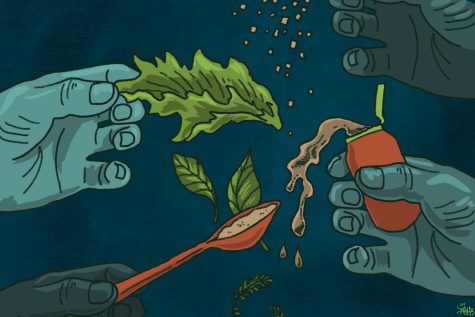Examining the pros and cons of milk
The Health Corner
I grew up being told milk was essential for my bones and health.
My mother always made me drink a tall glass of it with dinner and the “Got Milk?” slogan was ingrained in my mind with its constant appearances in classrooms, television ads and on posters.
Recently, however, I’ve noticed a variety of perspectives on whether the essential nutrients in milk outweigh the potential costs.
The U.S. is the largest producer of cow’s milk in the world, according to the Agricultural Marketing Resource Center.
In 2011, the AMR Center reported that the U.S. produced 196 billion pounds of milk, less than 28 percent of which was processed into fluid milk products.
Ivonne Headley, a senior Dietetics, Nutrition and Food Sciences major, completed a semester-long research project with one of her classmates on the nutritional advantages and disadvantages of various types of milk during infancy, she said.
She discovered that, unlike in the U.S., it is common to consume other forms of mammalian milk around the world.
“Goat’s milk and sheep’s milk are actually very common in other parts of the globe and have several benefits for infants,” Headley said. “Goat’s milk is high in vitamin A, which is great for vision, skin, bone and tooth growth, and sheep’s milk has actually been found to be more readily digested by infants compared to cow’s milk.”
Milk and milk products contribute to protein for muscles, riboflavin for energy, vitamin B12 for the nervous system, calcium for bone mass and potassium to help maintain a healthy blood pressure, according to the U.S. Department of Agriculture.
“There is nothing wrong [nutritionally] with cow’s milk [versus other mammalian milk],” Headley said. “Nowadays it has been fortified with several important vitamins such as Vitamin D, making its affordability and accessibility even more attractive.”
Vitamin D functions to maintain proper levels of calcium and phosphorus, which helps to build and maintain bones, according to the USDA, and their daily recommended amount of dairy for women and men ages 17 to 30 is three cups.
Many nutritionists advise to make fat-free or low-fat choices and limit the intake of products such as two percent reduced-fat milk and chocolate milk, which contain trans fats and added sugars, according to the USDA.
This is because a diet high in saturated fats and cholesterol can cause an increase in “bad” cholesterol, low-density lipoprotein in the blood, which the USDA says can increase the risk for coronary heart disease.
For those who are lactose intolerant or choose not to consume milk, the USDA advises to choose other calcium-rich foods, such as calcium-fortified juice, almond milk, soy products and kale to maintain a healthy dietary balance.
Although milk is a great source of nutrients, many individuals choose to forgo it for a variety of reasons. One main reason is that they maintain a vegan diet and lifestyle.
“I don’t drink milk as a vegan, because female cows are tied down and inseminated to become pregnant to be able to produce milk for us,” said senior Sarah Bullock.
Most cows undergo hormone injections in order to produce large quantities of milk, Bullock said.
According to PETA, artificial hormones are injected into cows to increase the rate at which they grow.
Although the production of milk is an ethical concern for many, the large amount of nutrients and vitamins in fortified milk products are beneficial to the body—it’s just a matter of finding the right fit for you.
“I believe it is important to know there are more options out there than what the mainstream American food industry advertises,” Headley said.











